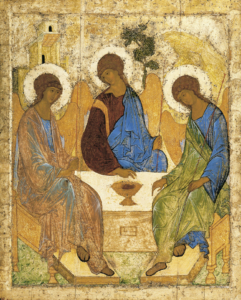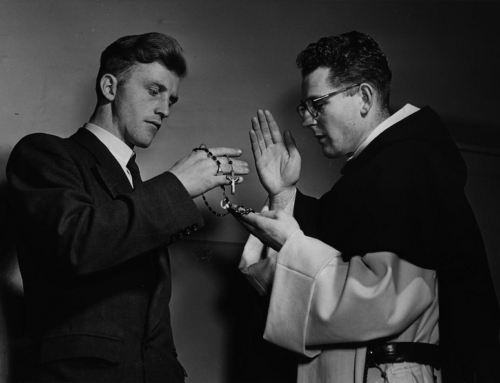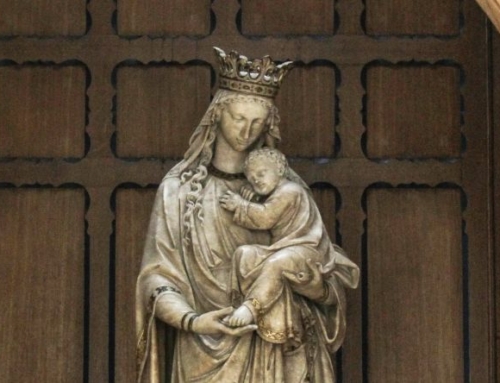St. Catherine of Siena was a mystic—the mystic of all mystics, perhaps. She had a profound relationship with the triune God and received many insights and graces from Him. She received the stigmata, although the wounds were kept hidden by God at her request. She was spiritually betrothed to Christ, accepting from Him a ring of espousal that was, again, most frequently invisible. She would fall into rapturous ecstasy, particularly after receiving the Eucharist.
Undergirding her mysticism is a robust theology. St. Catherine was a Dominican, and the character of the Order—prayer, study, and the sharing of that prayer and study with others—is abundantly clear in her writings. This connection is only fitting. St. Catherine was known to request that priests tell her about God when they would come to visit her, and her spiritual directors were always Dominicans. Her spiritual director for the longest length of time was Bl. Raymond of Capua, a Dominican friar who would frequently travel with her on her many journeys. Surely St. Catherine eagerly asked him to teach her about God during those times. The writings of St. Catherine are, therefore, a beautiful blending of Dominican doctrinal preaching and the personal mystical experiences she received.
We can begin to appreciate this marvelous harmony by looking at an excerpt of just one of her prayers. Here, in the midst of her reflection on the supernatural love of God, a distinctly natural image emerges, that of a meal. The image speaks in a profound way to the intimacy and familiarity God desires with man:
Eternal Goodness,
you want me to gaze into you
and see that you love me,
to see that you love me gratuitously,
so that I may love everyone
with the very same love.
You want me, then,
to love and serve my neighbors gratuitously,
by helping them
spiritually and materially
as much as I can,
without any expectation of selfish profit or pleasure.
Nor do you want me to hold back
because of their ingratitude or persecution,
or for any abuse I may suffer from them.
What then shall I do
to come to such a vision?
I shall strip myself
of my stinking garment
and by the light of most holy faith
I shall contemplate myself in you.
And I shall clothe myself in your eternal will.
By this light I shall come to know
that you, eternal Trinity,
are table
and food
and waiter for us.
You, eternal Father,
are the table
that offers us as food
the Lamb, your only-begotten Son.
He is the most exquisite of foods for us,
both in his teaching,
which nourishes us in your will,
and in the sacrament
that we receive in holy communion,
which feeds and strengthens us
while we are pilgrim travelers in this life.
And the Holy Spirit
is indeed a waiter for us,
for he serves us this teaching
by enlightening our mind’s eye with it
and inspiring us to follow it.
And he serves us charity for our neighbors
and hunger to have as our food
souls
and the salvation of the whole world
for the Father’s honor.
So we see that souls enlightened in you,
true Light,
never let a moment pass
without eating this exquisite food
for your honor.
We find in this prayer a profound consideration of God. This essay offers a theological reflection on this rich Trinitarian prayer, exploring first the image of the Trinity as table, food, and waiter; second, the soul’s capacity to taste God through sanctifying grace and the divine indwelling; and, finally, the hunger to feed on souls for the Father’s glory. Drawing upon elements from St. Catherine’s own life experience, her writings, and the Trinitarian theology of St. Thomas Aquinas, this reflection strives to help us appreciate how, by gazing toward the Lord with St. Catherine, we can come to know and love both the Creator and our fellow creatures better.
Table, Food, and Waiter
At the heart of this prayer is the message that God loves us, and wants us to love and serve others. When St. Catherine peers humbly into the mystery of the eternal Godhead, she sees that God serves us most generously, in a way that we can easily appreciate: in the context of a meal. God is table, food, and waiter for us. This is quite the domestic image of the Holy Trinity, an image that is fitting when one remembers Jesus’s promise at the Last Supper: “Whoever loves me will keep my word, and my Father will love him, and we will come to him and make our home with him” (Jn 14:23, emphasis added). Such an image would also be meaningful for St. Catherine, considering the many years she served her family at table. St. Catherine’s parents had wished to arrange a marriage for their daughter, but she had taken a private vow of virginity, and, as a punishment, she lived as a servant in the home for some time—a duty she fulfilled happily.
This meal image conveys something of the unity of the Triune God. For St. Catherine, it is not only the food that makes the meal, but also the table, as well as the service of the waiter. This image is a beautiful example of the way in which the Trinity always acts as one. If we think about the crucifixion, we see how Jesus Christ suffered and died on the cross, and how the cross was a kind of table prepared by the Father from all eternity for His Son. The bonds which, for our sake, held Christ fast to the cross were not mere nails, but were also the “bond of divine charity,” who is the Holy Spirit (Letter T99, The Letters of Catherine of Siena, vol. I, 15). Furthermore, that same Holy Spirit brings to us all the graces which are poured out in the Blood of Jesus Christ.
The Father is the one who prepares the table of the cross, but also, as St. Catherine writes in a letter, the Father is “for us a table bearing everything there is” (Letter Gardener 1, vol. I, 189). This metaphor captures a profound metaphysical reality: the unbegotten Father is the principle and support of all that is. Just as a table supports everything that happens at the meal, providing the place for the food and those being fed, so too does God hold all things in existence.
The image of the Son as food should come as no surprise to any Christian. Jesus Christ is the Bread of Life and the Passover Lamb slain for our sins. We must eat of this Lamb roasted on the spit of the cross by the flames of charity, that is the Holy Spirit, if we are to receive eternal life (Jn 6:54). St. Catherine herself was sustained in a miraculous way by the Eucharist. By the end of her life, she was unable to eat any food other than the Blessed Sacrament. This fast spanned the seven years prior to her death in 1380. Whenever she would try to eat, for instance when she was ordered to by her spiritual director, she would become terribly ill and suffer great pains. The Eucharist alone could she consume. Yet even with such harsh fasting, she still lived an incredibly active life, traveling, proclaiming the Gospel, and caring for the sick. It was the Eucharist that daily sustained and strengthened her. The Son was for her true sustenance.
The image of the Holy Spirit as waiter is very much in accord with His role as Advocate. He is our helper and brings to us the graces merited by Jesus Christ and poured out by the Father. Elsewhere St. Catherine supplies the image of Christ as a wine cask, and the Holy Spirit as a cellarer. She writes, “His humanity is the cask that encased the divine nature. The cellarer—the fire and the hands that are the Holy Spirit—tapped that cask on the wood of the most holy cross” (Letter T136, vol. I, 142). The Holy Spirit is the One who, so to speak, fills the precious chalice for those who feast on the Lamb. He gently guides and serves our hungry souls.
In St. Catherine’s imagery, we therefore find vivid descriptions of the essential unity and personal distinctions found in God. In another passage she writes,
Next the bride is welcomed by her bridegroom and led into the room where table, food, and waiter are found. The room is the divine essence, where the real connoisseurs are fed. There we experience the eternal Father as table, the Son as food, and the Holy Spirit as the one who waits for us. And so the soul experiences and is in truth filled with the eternal vision of God. (Letter T112, vol. II, 337)
The vision of God, to see God and know Him, is the desire of our souls. We are led to this vision by Christ the bridegroom. In this beatific vision we will see and know God both as one indivisibly united Essence and as three really distinct Persons. In this vision will we enjoy an eternal feast.
A Sweet Knowledge
In the prayer cited above, St. Catherine also reflects on Jesus as nourishment. We are nourished not only with the Eucharist but also with divine wisdom. The only-begotten Son is “the most exquisite of foods for us,” she writes, and that food takes the form of “his teaching, / Which nourishes us in [the Father’s] will.” The Holy Spirit is the waiter who “serves us this teaching / By enlightening our mind’s eye with it,” and He also “serves us charity for our neighbors.” In these lines, St. Catherine is using very concrete images to describe some of the richest mysteries of Trinitarian theology: the divine indwelling and the invisible missions of the Son and Holy Spirit. She is describing how we can come to “taste” God, so to speak.
These lines from St. Catherine can help us appreciate what it means to be in a state of sanctifying grace. It means that the Trinity can dwell in the human person in a special and personal way. In sanctifying grace, St. Thomas teaches, the Holy Trinity is personally present in the sanctified soul in a way that He is not present to the rest of the created universe. It brings the rational creature into union with the Creator. The Dominican theologian Fr. Gilles Emery explains that this is “a union in which the Triune God enters into intimacy with the human person, and the human being comes into the personal reality of God”—a union made possible by God’s gift of grace to the human person (The Trinitarian Theology of Saint Thomas Aquinas, 360).
We are meant to enjoy this union, to savor and delight in it in mind and heart. We receive the divine gifts of wisdom and charity, which work to perfect our intellect and the will. These gifts of wisdom and charity refer us to the divine Persons in their distinctiveness. In other words, we experience a share in the way that the divine Persons are related to each other. They give us a share in the relation of the Son (God’s wisdom) to the Father, and of the Holy Spirit (God’s love) to the Father and the Son.
When discussing how wisdom gives us a share in the way the Son is related to the Father, St. Thomas speaks of “intellectual illumination.” St. Thomas quotes St. Augustine, who in his work On the Trinity writes, “The Son is being sent whenever someone has knowledge or perception of him.” What might St. Augustine mean by perception? St. Thomas explains that “‘perception’ points to a kind of experiential awareness and this precisely is what wisdom is, a knowing that, as it were, is tasted” (Summa Theologiae I, q. 43, a. 5, ad 2). In the original Latin, we find that St. Thomas adds to the delight of this sacred truth by making a pun: wisdom (sapientia) is a sort of tasted knowledge (sapida scientia). Later in the Summa, St. Thomas again writes that by means of this kind of knowledge “a man experiences within himself the taste of God’s sweetness” (ST II-II, q. 97, a. 2, ad 2). St. Thomas refers to this experience as a “taste” of God because, in this life on earth, it is a spiritual experience that goes beyond words, like a meal so perfect that words fail to do it justice. A person in a state of sanctifying grace does not always have this sensible experience—indeed, the saints show us that we are called to hold on to the “loving knowledge” of Jesus even when our sense appetites feel nothing—but the experience of God’s sweet knowledge is possible.
Eating Souls
In her prayer, St. Catherine refers to the Holy Spirit’s mission of charity as something that stirs within the soul a hunger to feed on others’ souls. As waiter, the Holy Spirit
And he serves us charity for our neighbors
and hunger to have as our food
souls
and the salvation of the whole world
for the Father’s honor.
Paradoxically, the Holy Spirit serves up hunger as one of the courses. It does not sate the appetite, but rather stirs the appetite—inspiring a hunger to have souls as our food. We could say that this appetite is the heart of the theological virtue of charity, by which we love and desire what God loves and desires (that is, the good of our neighbors) precisely because God loves and desires this for them. This image of hungering for souls is a common one in St. Catherine’s writings. It is a particularly vivid image, one meant to convey a holy desire that draws us closer to Christ. Because of our union with Christ, we too must feed on souls at the table of the cross, filled with desire to help bring souls to that salvation won at Calvary. It is in accepting the crosses of our life that we participate in Christ’s saving mission, and so feed on souls.
The desire to feed on souls is a holy one for St. Catherine. It is meant to be positive. This stands in contrast to those who “devour” souls, which St. Catherine portrays as a negative activity. In one letter, for example, she writes against those pastors who “should be nourishing themselves on souls as their food . . . but instead . . . they are like wolves, not tending the little sheep, but devouring them” (Letter T327, vol. IV, 31–32). For St. Catherine, feeding on souls transforms souls in grace, whereas devouring souls leads to the demise of others’ souls, and one’s own. In this instance, what we eat becomes like us. But it should be noted that this process is inverted when we receive the Eucharist, as seen in St. Augustine:
I found myself to be far off from You, in the region of dissimilarity, as if I heard this voice of Yours from on high: “I am the food of strong men; grow, and you shall feed upon me; nor shall you convert me, like the food of your flesh, into you, but you shall be converted into me.” (Confessions, 7.10.16)
Drawing on St. Augustine, Fr. Romanus Cessario, O.P. explains that “we do not consume this heavenly food, but rather this food consumes us in the fire of charity and unites us in the bond of unity” (Theology and Sanctity, 51). Being consumed by Christ and the fire of charity in receiving the Eucharist, “we are then sharing in his warmth and in his power, in that we begin at once to feed on and savor souls. And we in turn change every other person into ourselves in love and desire, by giving them the color and taste for virtue that we have drawn from the wood of the most holy cross” (Letter T137, vol. I, 182). We must first be consumed by Christ in the Eucharist before we can ourselves feed on and transform souls. So, then, if Christ has first fed on us from the cross, and we have become like Christ through grace and the Eucharist, we can in turn feed on our neighbors so that they might become more like us, inasmuch as we are like Christ.
The purpose of this feeding on souls is not only for others’ salvation, but also for the Father’s honor. It is meant to give glory to God. Another repeated theme of St. Catherine’s is that we cannot love God as He deserves because we are creatures and He is the Creator. God has freely given us all we possess and we are eternally indebted to Him. Because of this debt, any love we show Him is owed to Him (and, indeed, even the love we do not show Him is owed to Him). We can only try to imitate God’s gratuitous love in and for our neighbors, to whom we owe no such debt. We do this by receiving from the Holy Spirit, as waiter, the food that is a hungering for souls.
Eating Often
St. Catherine’s mystical experiences equip her with a profound set of images, making deep theological truths intelligible to those who read her prayers. The common experience of eating at table elucidates brilliant facets of the Trinity, and we are encouraged to seek the salvation of our neighbors by feeding on their souls. Just as we require daily sustenance, so we should be attentive daily to the feast prepared for us by God. We should be eating this food constantly, as St. Catherine suggests at the end of the prayer quoted above. Souls enlightened by God, she writes, “never let a moment pass / without eating this exquisite food / for [God’s] honor.” Through this nourishment, we come to taste God.
✠
Image: Andrei Rublev, The Trinity (Wikimedia Commons)
Download a PDF of this article here.




